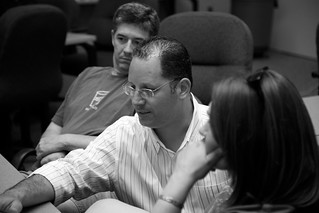Are Mistakes Reflections of the Students or the Teacher?
3/11/2006 12:00:00 amNancy over at Random Thoughts writes:
Are the mistakes of my students a reflection on me and my teaching?In a comment to my previous post, Bronwyn indicated that they are. In the not-too-distant past I would have agreed with her; I felt that if my students appeared to be less than perfect, it somehow meant I was not a "good" teacher. But now I have to say that I don't agree.
Learning requires the active participation of the learner. Unfortunately, many students see learning as something that someone else does to them.
I think that a student's published work is a reflection of the student. When they do a good job it reflects well on them and when they don't it doesn't. The real "blog juice" is the global audience. When kids finally realize that what they write is being read and talked about by people across the globe they are inspired to do better work; they want to make a good impression. This is why I think it's so important for teachers to emphasize the fact that publishing to a blog is publishing for a global audience. Students need to be reminded many times before they "get it." This is the main reason all my class blogs have Visitor Maps. They were installed, but invisible, for the first two weeks of the semester. When the map links went live the students were able to "see" their audience immediately.
As for student performance being a reflection on the teacher, well, it is. That you encourage and orchestrate the publication of student work is an act of bravery in our profession. Many educators have a fear of transparency. Those that don't are powerful examples for their students (and colleagues).
If anyone judges your work through your students work then they should look at the work of your very best students. The ones who followed your lead, took your advice and engaged you and the content you teach. That would be an authentic example of the learning opportunities you create for your students. It also stands as a model for other students to build on; and we all need good models to look up to.
Keep up the good work Nancy!



2 comments
Thanks so much! I really do appreciate the kind words. And I appreciate the example you set and the ideas you give me.
ReplyDeleteI am definitely going to look into visitor maps. I think they could be very motivating.
And I am going to keep on publishing student work.
The code for the visitor maps comes in two pieces.
ReplyDeletePart one is a bit of java script that is always invisible, it's the code that the site gives you to paste into your template when you create the map.
Part two is the actual link to the map itself. The link is generated at the same time the java script is.
Install part one immediately -- even before the class first meets.
Part two, the hyperlink to the map itself, can also be installed immediately. you can make it invisible by inserting an ! as the first character of the html code.
for example this link:
<a href="PutUrlHere.com">this text will be the link</a>
can be made invisible by editing it to look like this:
<!a href="PutUrlHere.com"><!this text will be the link><!/a>
Remove these edits to make it visible again.
Email me if this still sounds confusing. ;-)